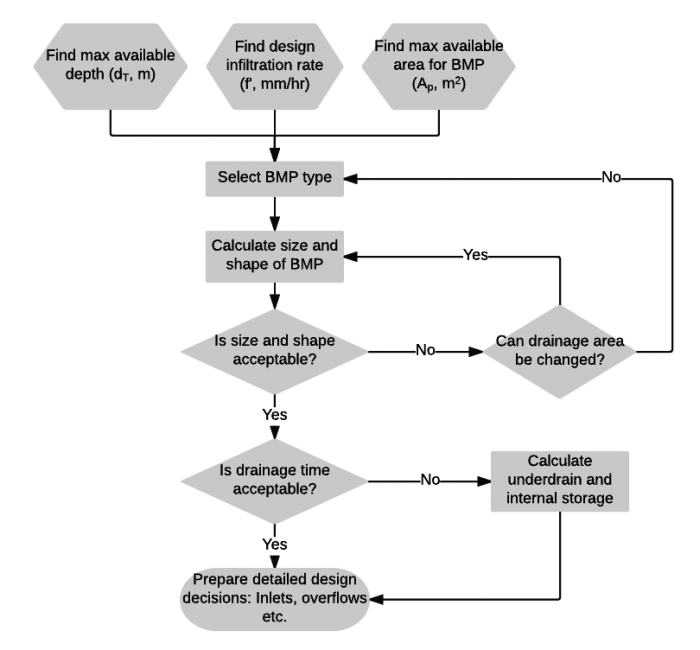Infiltration: Sizing and modeling
- To calculate the require depth of an infiltration facility in a specified footprint area...
- To calculate the required footprint area of an infiltration facility with a known depth constraint....
- To calculate the infiltration time of ponded water on the surface of a facility footprint...
- To calculate the drainage time of an underground infiltration facility...
The sizing calculations require that most of the following parameters be known or estimated. The exceptions are the depth (d) and practice permeable footprint area (Ap), as only one of these is required to find the other. Note that some of these parameters are limited:
- The maximum total depth will be limited by construction practices i.e. usually ≤ 2 m.
- The maximum total depth may be limited by the conditions underground (e.g. the groundwater or underlying geology/infrastructure).
- The maximum total depth may be limited by the need to support vegetation cover over it (e.g. at least 30 cm of planting soil backfill over the BMP to support grasses)
- Infiltration trenches, chambers and bioretention have a maximum recommended I/P ratio of 20.
| Symbol | Units | Parameter |
|---|---|---|
| D | hrs | Duration of design storm (for MECP volume based calculations set to 1) |
| i | mm/hr | Intensity of design storm (for MECP volume based calculations use whole storm depth (link to map)) |
| f' | mm/hr | Design infiltration rate of the underlying native soil, calculated from measured infiltration rate and applied safety factor |
| n | - | Porosity of the aggregate or other void producing fill material. *Note: For systems that have significant storage in clear open chambers surrounded by clear stone aggregate, an effective porosity value (n') may be estimated for the whole installation and used in the calculations below. Effective porosity will vary according to the geometry of the storage chambers, so advice should be sought from product manufacturers. Permit applications should include the basis for n' estimates. |
| Ai | m2 | Impermeable area within the catchment |
| d | m | Depth of the practice, total of all components |
| Ap | m2 | Permeable footprint area of the practice |
| x | m | Perimeter of the practice |
| K | mm/hr | Hydraulic conductivity of the filter media or planting soil used in the practice |
This spreadsheet tool has been set up to perform all of the infiltration practice sizing calculations shown below
To calculate the required depth, where the area of the facility is constrained (3D)[edit]
In some very constrained sites, the surface area of the BMP may be limited, in this case the required depth of cell or trench can be calculated:
Where and
(The rearrangement to calculate the required footprint area of the facility for a given depth using three dimensional drainage is not available at this time. Elegant submissions are invited.)
To calculate the required depth, where the area of the facility is constrained (1D)[edit]
In some very constrained sites, the surface area of the BMP may be limited, in this case the required depth of cell or trench can be calculated. Note that in most cases the results of this calculation will be very similar to those of the above equation using 3D infiltration.
To calculate the require facility area or footprint where the depth is constrained (1D)[edit]
In many locations throughout Ontario, there may be limited depth of soil available into which stormwater may be infiltrated. In this case the required storage needs to be distributed more widely across the landscape. The overall are of BMP required can be calculated:
Time for infiltration of surface ponded water[edit]
The following equation assumes that infiltration occurs primarily through the footprint of the facility. It is best applied to calculate the maximum duration of ponding on the surface of bioretention cells, bioswales and enhanced grass swales to ensure all surface ponding drains within 48 hours. To calculate the time (t) to fully drain surface ponded water through the filter media or planting soil: Where d is the mean ponding depth
Drainage time to empty facility[edit]
The target drainage time for the internal storage of an infiltration facility is typically between 48 and 72 hours or based on the average inter-event period for the location. See Drainage time for more information about how inter-event periods vary across Ontario and to help select what is suitable for the site.
Try the Darcy Drainage calculator tool for estimating drainage time assuming either one or three-dimensional drainage from the practice:
For some geometries (e.g. particularly deep facilities or linear facilities), it preferable to account for lateral infiltration.
The 3D equation make use of the hydraulic radius (Ap/x), where x is the perimeter (m) of the facility.
Maximizing the perimeter of the facility directs designers towards longer, linear shapes such as infiltration trenches and bioswales.
To calculate the time (t) to fully drain the facility:
Where "ln" means natural logarithm of the term in square brackets

![{\displaystyle d=a[e^{\left(-bD\right)}-1]}](https://wikimedia.org/api/rest_v1/media/math/render/svg/8b7aff54e8cdb29929df7ac7ee3815c6bb830270)


![{\displaystyle d={\frac {D\left[\left({\frac {Ai}{Ap}}\right)i-f'\right]}{n}}}](https://wikimedia.org/api/rest_v1/media/math/render/svg/781a493d3007f02d45f06a5fe643dd631e96880c)



![{\displaystyle t={\frac {nAp}{f'x}}ln\left[{\frac {\left(d+{\frac {Ap}{x}}\right)}{\left({\frac {Ap}{x}}\right)}}\right]}](https://wikimedia.org/api/rest_v1/media/math/render/svg/d881e6814bfc0a64f2fdb231197e3e2f2cae9da9)